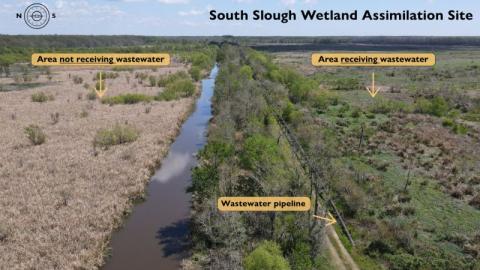Scientific dispute over using sewage to restore Louisiana’s wetlands turns political
Opposing views among environmental groups and coastal scientists in Louisiana have spurred intense debates over the use of treated sewage to restore Louisiana’s wetlands. The conflicts could jeopardize some decades-long efforts to restore the state’s collapsing coast.
Wetlands are sometimes referred to as the kidneys of the earth — and for good reason. They keep water clean by filtering out pollutants and managing the amount of nutrients, such as nitrogen and phosphorus, that can lead to the harmful algae blooms that create “dead zones” without the oxygen needed to support aquatic life.
Wetlands can even be created to treat wastewater processed from sewage treatment plants. The practice can avoid polluting rivers and streams while providing valuable habitat.
But in Louisiana, the use of natural wetlands for wastewater treatment is a topic rife with controversy.
Originally pitched as a method of coastal restoration, a natural assimilation wetland is typically an area of degraded forested swamp or marshland where disinfected treated sewage water is pumped in an effort to push away saltwater, provide nutrients for the growth of plants and trees, and reverse the sinking and eroding of the land. Louisiana’s 3 million acres of wetlands, which include coastal marshes and swamps, are lost at the rate of roughly 75 square kilometers annually and are on pace to entire destruction within 200 years, according to the U.S. Geological Survey.
Both federal and state regulators permit local wastewater utilities to use natural wetlands for assimilation. One of the sites, located in Breaux Bridge, began in the 1940s as the city’s solution to discharging its treated wastewater. But it wasn’t until around the 1980s when LSU scientists began using and studying assimilation wetlands as a way to rebuild Louisiana’s coast. There are now 15 such assimilation sites across the state.
Local utilities and scientists, led by wetlands ecologist John Day, believe assimilation sites have been largely successful in restoring wetlands. Day is one of the LSU researchers who spearheaded their use for coastal restoration. He founded Comite Resources, a company of environmental scientists who work on coastal restoration projects and currently monitor a few of the assimilation wetland sites.
On the other side of the debate is Eugene Turner, emeritus professor of coastal sciences at LSU, who says assimilation is killing rather than restoring wetlands. Turner has a vocal public following, including organizations such as the Ponchartrain Conservancy and Louisiana Wildlife Federation, that has rallied around his argument: Feeding treated wastewater to Louisiana’s wetlands hurts rather than helps.
Such disagreements are a normal and even necessary part of science, but Day and his colleagues say Turner’s side is venturing outside the scientific process and lobbying state lawmakers to halt the projects in an “undemocratic” manner.

